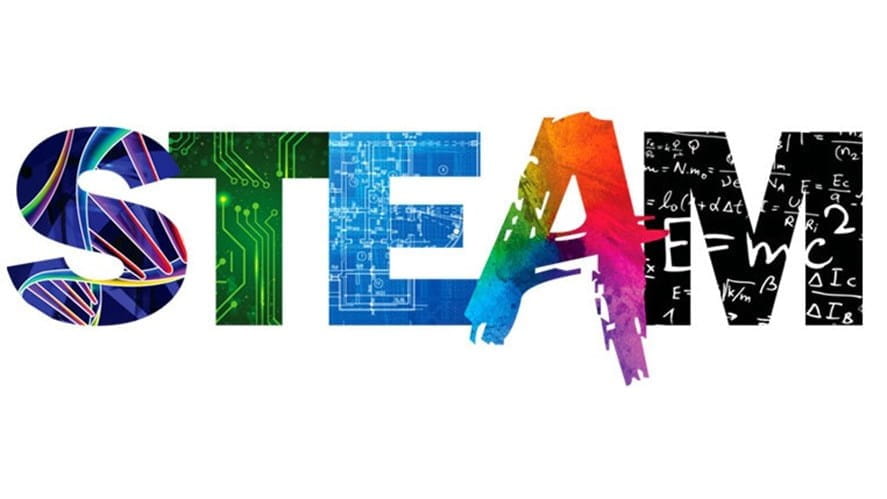We use cookies to improve your online experiences. To learn more and choose your cookies options, please refer to our cookie policy.

WHAT IS STEAM?
“STEAM is an educational approach to learning that uses Science, Technology, Engineering, the Arts and Mathematics as access points for guiding student inquiry, dialogue, and critical thinking. The end results are students who take thoughtful risks, engage in experiential learning, persist in problem-solving, embrace collaboration, and work through the creative process. These are the innovators, educators, leaders, and learners of the 21st century!” Susan Riley, https://educationcloset.com/steam/what-is-steam/
THE HISTORICAL PERSPECTIVE
A quick look at the historical perspective helps to place STEAM learning into context.
Under the tutelage of the Greek philosophers, students learned rhetoric (the art of speaking and writing), music (dancing, singing and playing instruments), theatre, ethics, mathematics and astronomy. There was a close connection between mathematics and music.
"From what has been said, it is clear what influence music has on the disposition of the mind, and how it can fascinate it - and if it can do so, it is undeniable that young people must be educated." - Aristotle
For Leonardo Da Vinci, the arts and the sciences coexisted naturally.
"Science makes a better artist, art makes a better scientist." Leonardo Da Vinci
Furthermore, by studying the writings, journals and outputs of these inventors we learn that their interdisiciplinary nature of learning helped their thinking to develop exponentially rather than incrementally. Perhaps neglected in traditional educational systems, is putting the thinking into action.
"I have been impressed with the urgency of doing. Knowing is not enough; we must apply. Being willing is not enough; we must do." - Leonardo da Vinci
Similarily, if we look at the work of JS Bach or MC Escher, the relationships between mathematics and art are strongly intertwined. But that is discussion for another article. We can, however, surmise that both disciplines share many more similarities in terms of process-driven discovery than not, and are in fact complementary.
THE ARTS IN STEAM
The recent contribution of the Arts to STEM, around ten years ago, was an important one. The Arts, which incorporates the humanities, have the power to humanise and bring meaning to our lives. They allow us to explore who we are and learn about our roles in life. They allow us to engage in dialogue, search for solutions to open-ended problems, to develop process-driven approaches. STEAM allows individuals to apply these arts principles, practices, and processes to their learning. STEAM professionals have to engage with complex questions or abstract ideas of inclusion, morals, rights, values and meaning and as our educational system needs to engage students with issues of ethics and responsibility in science and technology, STEAM’s interdisciplinary learning lends itself to this. We must not forget, however, that the Arts exist in their own right, but they too can be used as a lever to exponential growth in a STEAM-fortified curriculum.
HOW TO STEAM?
Borrowing from both scientific investigation and process-driven arts exploration, pupils learn to analyse, create, reflect and improve. They learn to document their learning journeys and allow ideas to unfold and grow. They learn to work in teams with others who hold complementary strengths. They seek feedback from experts. Projects are not outcome-driven. It is the means to the end which is important; the creative approach which leads to discovery and brings meaning to the individual. Teachers teach core skills, but they also give opportunities for pupils to think about unsolved deep questions and give them time to explore possible solutions. Portfolios of work show the depth of skill developed. They teach collaboration and involve pupils at social-emotional levels to a greater extent than standardised tests do.
THE CHALLENGE
One of the major challenges for schools today, is to learn how to STEAM; how to integrate discrete subject areas into other fields without compromising depth. Can a subject be true to itself, if it is integrated into other domains? How could discrete subjects possibly contribute to a cohesive curriculum?
To summarise, STEAM is really about humanity, it's really about helping people by using STEAM kind of thinking and doing. To be able to actually come up with a solution to an idea and then see it in your hands and be able to press a button and for it to be in millions of people's hands is empowering. We're the first generation in the world to have that kind of experience. Thus as STEAM pedagogical approaches help to shift passive learners into active ones, let’s be prepared for it, let’s be proactive and not reactive. Let us all exercise our responsibilities to shape the environment we want for our children and leave behind a mindful and meaningful legacy.
ANNA SIKORA
Enseignante Informatique
EduTech & STEAM / MIT Lead